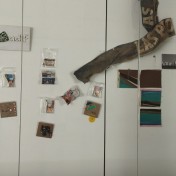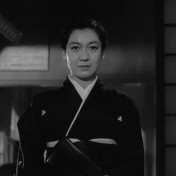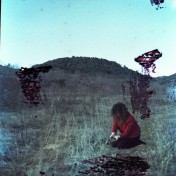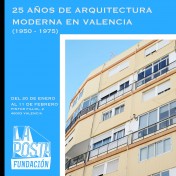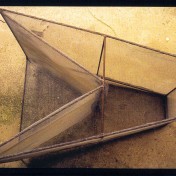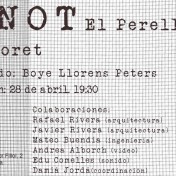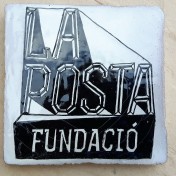In the video game exhibition “Devil Sun: Surviving Japanese Survival Horror”, curated by Aitor de Maenza and Sergio Martín, works by three great Japanese artists are on display: Osamu Sato, Kenji Eno and Kikiyama. We cannot say much about Kikiyama, as he jealously hides his identity. But, as far as Osamu Sato and Kenji Eno are concerned, it should be noted that they are not only graphic designers and video game developers, but also musicians.
Entropic landscapes. The exhibition
Texts
The exhibition “Entropic Landscapes” is the end of the Workshop on Entropic Landscape, forming part of the [simulated] public participation process that has been proposed as part of the program of said Workshop, because, is in this way like all the rules and protocols of action in relation to with the declaration of Cultural Landscapes and Historical Sites demand it. From this perspective of the public participation process, what the exhibition seeks, like the rest of the activities planned in the public participation plan prepared by the participants in the Workshop, is to transmit to the public the experience of the identification and characterization of entropic landscapes, that we have been discovering in the different routes developed during the Workshop.
Nothing is what it seems. Cinema and its formats
Texts
(VAL) ˂VHS/VOD/TikTok/Cine˃ El cinema i els seus formats, exposició de cinema expandit comissariada per Aitor de Maenza i Guillem Cervera, inclou els audiovisuals següents:
“Morbo Queer / InsuMisa” by Anna Maria Staiano and Graham Bell Tornado: between Eros and Thanatos
Texts
Like the rustling of the old leaves in a cemetery, this is how our soul sounds when it is pushed by an unhealthy love into the still empty hole. After that nothing will be the same again, and our youth will be over without having had a chance to begin. We will only be able to make an ex-voto imagining what could have been, so as not to end up losing hope definitively. Eugen Ehrlich
“Jardim de Entropias sob Brahma Grama”
Texts
“Entropy Garden under Brahma Grass” The installation “Ecology: the necessary evil” specially designed and executed for the La Posta Foundation space by the artists Janice Martins Appel and Domingo Mestre (Serpiente de 2 Cabezas), with elements built specifically for the occasion and other natural ones as still lifes (in a multimedia context that includes various video projections, transparencies, etc.), it can be visited from May 12 to June 10, 2023 and will serve as the setting for a large program of activities.
Spurensicherung in “Cross-border Motherhood” by Gabriela Rivera Lucero
Texts
The first thing that draws attention in the photographs that are exhibited in "Cross-border Motherhood" by Gabriela Rivera Lucero, is that the photographs show the traces of an intervention on them. The artist herself has explained that the negatives were introduced before their development in a liquid in which objects and vegetable plants related to the life experience of the photographed women had been bathed. There is a call to incorporate memories and images that tell us about other things that are beyond the image that is shown, as indications of something that cannot be seen but that can be sensed. With this, Gabriela's work is part of a current of thought and work that seeks to discover the past in the small signs that appear before us, many times without having been summoned.
25 years of Modern Architecture in Valencia (1950-1975). Text complete
Texts
Our architectural heritage is an element of cultural identity and of great collective wealth. The study of it must be important for the dissemination, knowledge and enjoyment of future generations. There are many interesting buildings in the city of Valencia that do not have an adequate study. In the same way it happens with a large number of architects, with works of great importance in those years, who do not have their own monograph.
El Perellonet, the “monot” and the transfer of knowledge
Texts
Sometimes extreme situations serve to spur the human imagination. At the beginning of the 20th century, some men from the city of Valencia, fed up with starving themselves and their families, decide to seek their fortune (or at least eat), settling in the 30s of the last century in some barracks next to the gola del Perellonet, and decide to dedicate themselves to elver fishing. They were the first in Spain to have that idea, and to carry it out they devised a unique artifact of its kind: the monot.
Of riggings and monuments or about the “Monot” by Ana Lloret
Texts
A snow shovel was probably the first work tool turned into a work of art, in Marcel Duchamp's New York studio in 1915. It was about questioning the status of the artistic object from a perspective that complied with the modern demand that the art was proper of its time, of its historical moment. The provocative and burlesque spirit of Duchamp was used by Claes Oldenburg to, from the pop tradition, represent everyday utensils (shovels, hammers, saws, spoons...) with a diagrammatic aspect, an exaggerated scale and a denatured context that sought to cause some confusion in the viewer that will force him to reflect on his relationship with culture and art.
La Posta Foundation begins a new stage
Texts
La Posta Foundation starts the 21/22 season with a boost of rebirth, new illusions and energies and a totally renewed team.


